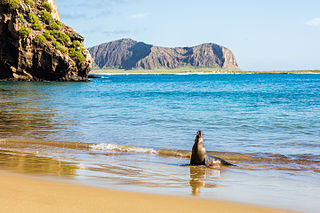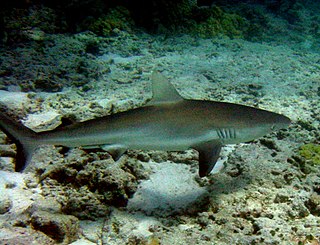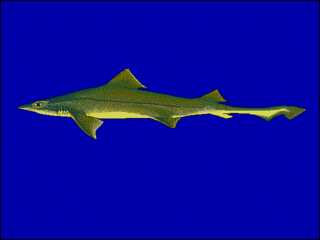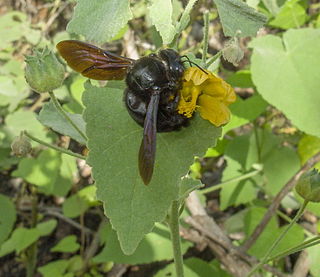
The Galápagos Islands are an archipelago of volcanic islands. They are distributed on each side of the equator in the Pacific Ocean, surrounding the centre of the Western Hemisphere, and are part of the Republic of Ecuador. Located 900 kilometres west of continental Ecuador, the islands are known for their large number of endemic species that were studied by Charles Darwin during the second voyage of HMS Beagle. His observations and collections contributed to the inception of Darwin's theory of evolution by means of natural selection.

Mockingbirds are a group of New World passerine birds from the family Mimidae. They are best known for the habit of some species mimicking the songs of other birds and the sounds of insects and amphibians, often loudly and in rapid succession. There are about 17 species in two genera, although three species of mockingbird from the Galapagos Islands were formerly separated into a third genus, Nesomimus. The mockingbirds do not appear to form a monophyletic lineage, as Mimus and Melanotis are not each other's closest relatives; instead, Melanotis appears to be more closely related to the catbirds, while the closest living relatives of Mimus appear to be thrashers, such as the sage thrasher.

Darwin's finches are a group of about 18 species of passerine birds. They are well known for their remarkable diversity in beak form and function. They are often classified as the subfamily Geospizinae or tribe Geospizini. They belong to the tanager family and are not closely related to the true finches. The closest known relative of the Galápagos finches is the South American dull-coloured grassquit. They were first collected when the second voyage of the Beagle visited the Galápagos Islands, with Charles Darwin on board as a gentleman naturalist. Apart from the Cocos finch, which is from Cocos Island, the others are found only on the Galápagos Islands.

The Galápagos fur seal is one of eight seals in the genus Arctocephalus and one of nine seals in the subfamily Arctocephalinae. It is the smallest of all of the eared seals. They are endemic to the Galápagos Islands in the eastern Pacific. The total estimated population as of 1970 was said to be about 30,000, although the population has been said to be on the decline since the 1980s due to environmental factors such as pollution, disease, invasive species, and their limited territory. Due to the population having been historically vulnerable to hunting, the Galápagos fur seal has been protected by the Ecuadorian government since 1934

The Galápagos Islands xeric scrub, also known as the Galápagos Islands scrubland mosaic, is a terrestrial deserts and xeric shrublands ecoregion that covers the Galápagos Islands. The Galápagos Islands are volcanic in origin, and remote from continents and other islands. The ecoregion is well known for its unique endemic species, including giant tortoises, birds, and marine iguanas, which evolved in isolation to adapt to islands' environments.

The Galapagos shark is a species of requiem shark, in the family Carcharhinidae, found worldwide. It favors clear reef environments around oceanic islands, where it is often the most abundant shark species. A large species that often reaches 3.0 m (9.8 ft), the Galapagos reef shark has a typical fusiform "reef shark" shape and is very difficult to distinguish from the dusky shark and the grey reef shark. An identifying character of this species is its tall first dorsal fin, which has a slightly rounded tip and originates over the rear tips of the pectoral fins.

The spotted houndshark, Triakis maculata, is a houndshark of the family Triakidae found in tropical waters in the eastern Pacific Ocean off the coast of South America. It usually grows to a length around 180 centimetres (71 in). The reproduction of this houndshark is ovoviviparous, with a litter of 14 pups being found in one female with a birth size of 30 to 40 centimetres. Their diet is believed to consist mainly of crustaceans.

The speckled smooth-hound is a houndshark of the family Triakidae. It is found on the continental shelf of the eastern Pacific, between latitudes 0° and 54° S, at depths between 16 and 50 m. It can reach a length of 130 cm (51 in). Collectively with certain other species of shark, it is known as "tollo".

The Galápagos tortoise or Galápagos giant tortoise is a species of very large tortoise in the genus Chelonoidis. The species comprises 15 subspecies. It is the largest living species of tortoise, with some modern Galápagos tortoises weighing up to 417 kg (919 lb). With lifespans in the wild of over 100 years, it is one of the longest-lived vertebrates. Captive Galapagos tortoises can live up to 177 years. For example, a captive individual, Harriet, lived for at least 175 years. Spanish explorers, who discovered the islands in the 16th century, named them after the Spanish galápago, meaning "tortoise".

Onchidella is a genus of small, air-breathing sea slugs, shell-less marine pulmonate gastropod molluscs in the family Onchidiidae.

Corymbia maculata, commonly known as spotted gum, is a species of medium-sized to tall tree that is endemic to eastern Australia. It has smooth, mottled bark, lance-shaped to curved adult leaves, flower buds usually in groups of three, white flowers and urn-shaped or barrel-shaped fruit.

Dactylorhiza maculata, known as the heath spotted-orchid or moorland spotted orchid, is an herbaceous perennial plant of the family Orchidaceae. It is widespread in mountainous regions across much of Europe from Portugal and Iceland east to Russia. It is also found in Algeria, Morocco, and western Siberia.

Lonesome George was a male Pinta Island tortoise and the last known individual of the subspecies. In his last years, he was known as the rarest creature in the world. George serves as an important symbol for conservation efforts in the Galápagos Islands and throughout the world.

Lysiosquillina maculata, the zebra mantis shrimp, striped mantis shrimp or razor mantis, is a species of mantis shrimp found across the Indo-Pacific region from East Africa to the Galápagos and Hawaiian Islands. At a length up to 40 cm, L. maculata is the largest mantis shrimp in the world. L. maculata may be distinguished from its congener L. sulcata by the greater number of teeth on the last segment of its raptorial claw, and by the colouration of the uropodal endopod, the distal half of which is dark in L. maculata but not in L. sulcata. A small artisanal fishery exists for this species.

The Galápagos penguin is a penguin endemic to the Galápagos Islands, Ecuador. It is the only penguin found north of the equator. Most inhabit Fernandina Island and the west coast of Isabela Island. The cool waters of the Humboldt and Cromwell Currents allow it to survive despite the tropical latitude. The Galápagos penguin is one of the banded penguins, the other species of which live mostly on the coasts of Africa and mainland South America. It is one of the smallest species of penguin in the world. Because of their warm environment, Galápagos penguins have developed techniques to stay cool. The feathers on their back, flippers, and head are black, and they have a white belly and a stripe looping from their eyes down to their neck and chin. Each penguin keeps only one mate, and breeds year-round. Their nests are typically in caves and crevices as protection against predators and the harsh environment. The Galápagos penguin has a lifespan of about 15 to 20 years, but due to predation, life expectancy in the wild could be significantly reduced.

The garden eels are the subfamily Heterocongrinae in the conger eel family Congridae. The majority of garden eels live in the Indo-Pacific, but species are also found in warmer parts of the Atlantic Ocean and East Pacific. These small eels live in burrows on the sea floor and get their name from their practice of poking their heads from their burrows while most of their bodies remain hidden. Since they tend to live in groups, the many eel heads "growing" from the sea floor resemble the plants in a garden. They vary greatly in colour depending on the exact species involved. The largest species reaches about 120 cm (47 in) in length, but most species do not surpass 60 cm (24 in). Garden eel colonies can grow as large as one acre in surface area.

Canthidermis maculata, also known as rough triggerfish or spotted oceanic triggerfish, is a species of triggerfish native to the tropical and subtropical oceans worldwide. Unlike most triggerfish, they are mostly pelagic.

Xylocopa darwini, the Galápagos carpenter bee, is the only native species of bee in the Galápagos Islands, to which it is endemic. Altogether, only three species of bee are found in the islands. This species found on 75% of the largest islands. It is sexually dimorphic and is known for its complex behavior. As the only native bee, Xylocopa darwini serves as an important primary pollinator within the plant-pollinator network of the archipelago.
Cissites auriculata, the big-eared blister beetle, is a species of blister beetle in the family Meloidae. It is found in the Caribbean and Central America.


















